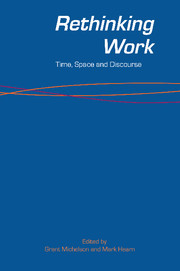Book contents
- Frontmatter
- Contents
- Tables and Figure
- Contributors
- Editorial Statement
- Abbreviations
- 1 Going to a New Place
- PART I TIME
- 2 Time and Work
- 3 The Gender Agenda
- 4 Regulation and Deregulation in Australian Labour Law
- 5 Diversity and Change in Work and Employment Relations
- 6 Transactions in Time
- PART II SPACE
- PART III DISCOURSE
- COMMENTARY
- Index
3 - The Gender Agenda
Women, Work and Maternity Leave
Published online by Cambridge University Press: 05 June 2012
- Frontmatter
- Contents
- Tables and Figure
- Contributors
- Editorial Statement
- Abbreviations
- 1 Going to a New Place
- PART I TIME
- 2 Time and Work
- 3 The Gender Agenda
- 4 Regulation and Deregulation in Australian Labour Law
- 5 Diversity and Change in Work and Employment Relations
- 6 Transactions in Time
- PART II SPACE
- PART III DISCOURSE
- COMMENTARY
- Index
Summary
At the beginning of the 21st century, women constitute close to half the paid workforce and represent over 40 per cent of trade union membership in Australia. Like men, they are ‘breadwinners’, contributing to household incomes, organisational profits and the national economy; but they continue, disproportionately, to be also the ‘breadmakers’, combining the domestic responsibilities of mothering and caring with paid work and careers. There is a clear gendered distribution of time in the household, with repercussions in the workplace (HREOC 2005). For women in particular, the changes in workforce participation have increased the stresses on the allocation of time between work, family, leisure and other activities.
In Australia, these changing social patterns have not been recognised with commensurate changes in policy or adequate re-evaluation of women's contribution to the paid workforce. There are clear policy lags and inequities in the distribution of wages and entitlements (Burgess & Baird 2003), and one area in particular shows that women do not receive adequate recognition for their multiple work and family roles. This is the availability of paid maternity leave. Although there has been considerable discussion and debate about the choices and constraints on women's ability to take time out of their working lives to bear and raise children, Australia remains one of only two industrialised nations (the other is the USA) without statutory paid maternity leave for working women.
Information
- Type
- Chapter
- Information
- Rethinking WorkTime, Space and Discourse, pp. 39 - 59Publisher: Cambridge University PressPrint publication year: 2006
Accessibility standard: Unknown
Why this information is here
This section outlines the accessibility features of this content - including support for screen readers, full keyboard navigation and high-contrast display options. This may not be relevant for you.Accessibility Information
- 2
- Cited by
